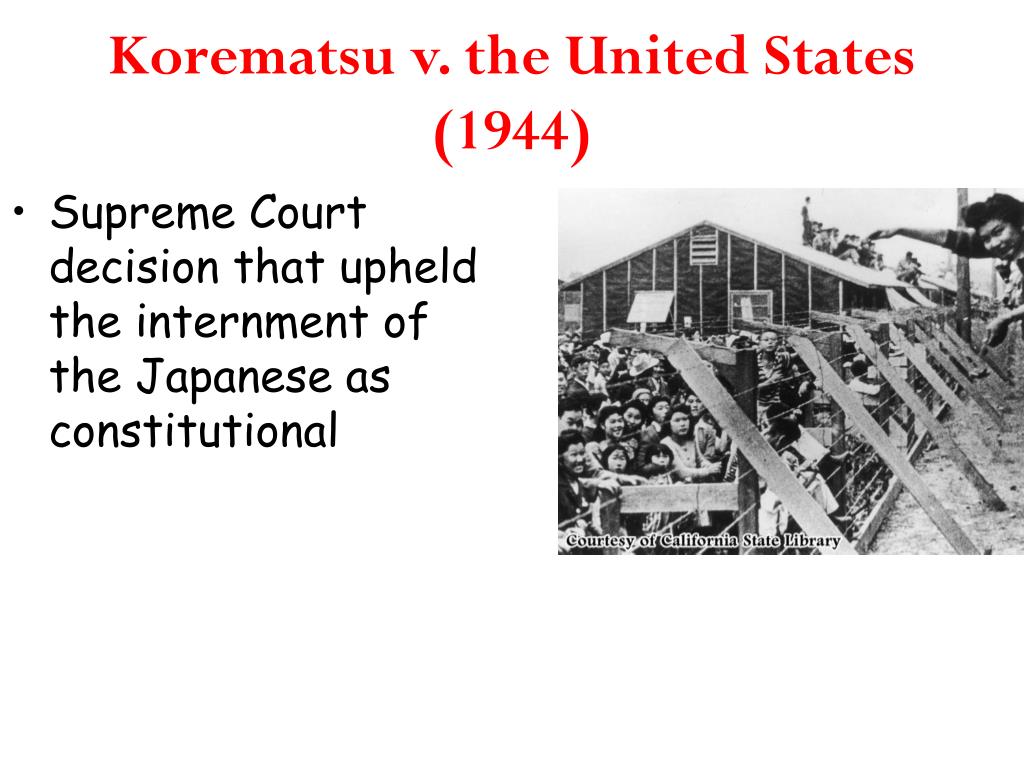
On May 30, 1942, however, government authorities finally tracked him down. But Korematsu was in love with an Italian-American girl and decided he did not want to leave his home near Oakland.Īfter refusing to report for internment, Korematsu changed his name and even underwent eyelid surgery to make him look less Japanese. He was 22-years-old in 1942 when General DeWitt ordered everyone of Japanese ancestry in the Western United States to report to assembly centers. The government classified these individuals as "disloyal." The Korematsu Caseīorn of Issei immigrant parents in Oakland, California, Fred Korematsu was a Nisei and an American citizen. Most did, but about 4 percent refused, protesting how they had been treated. Once in the camps, however, the government asked them to sign a loyalty oath to the United States.
#KOREMATSU V UNITED STATES 1944 TRIAL#
citizens, none had a hearing or trial before the government locked them up in relocation camps. Even so, almost all cooperated with General DeWitt's orders, believing that by doing so they proved their loyalty.Īlthough more than 60 percent of those ordered to evacuate were U.S. When ordered to evacuate, Issei and Nisei families usually had only a few days to sell their homes, businesses, vehicles, and other property. When they reported, the government transported them to permanent "relocation centers," the guarded prison camps where they would remain for up to four years. Starting on March 2, 1942, General DeWitt issued orders requiring all persons of Japanese ancestry in eight Western states to report to temporary assembly centers.

The stated purpose of removing this entire ethnic group was for "protection against espionage and against sabotage." Congress made it a crime to refuse to leave a military area when ordered to do so. This order affected about 120,000 citizens and non-citizens of Japanese origin. This gave General DeWitt authority to order the mass evacuation of Issei and Nisei from the West Coast and other military areas. On February 19, 1942, President Roosevelt issued Executive Order 9066. Roosevelt, however, accepted General DeWitt's recommendation. The Justice Department, FBI, and Army intelligence all concluded that such a drastic action was not necessary. Working with others in the War Department, General DeWitt developed a plan to remove all the Issei and Nisei from their homes in the Western states and lock them in prison camps. He said that the lack of any sabotage on the West Coast only proved that they were waiting for the Japanese invasion to begin. Without any real evidence, he believed that people of Japanese ancestry, citizens and non-citizens alike, could not be trusted. DeWitt was responsible for the defense of the West Coast. But when the Army and FBI investigated these rumors, they found them to be false. Rumors spread about Japanese Americans preparing to aid a Japanese invasion of the United States. They demanded that "something be done" about the Issei and Nisei living there. In the months following the attack on Pearl Harbor, pressure mounted from politicians on the West Coast. Sixty-three percent of them were Nisei, American-born citizens. Despite discrimination, the Issei and Nisei had built thriving ethnic communities in California and the West Coast. In 1940, 127,000 persons of Japanese ancestry lived in the United States, mostly in California. The Nisei thought of themselves as Americans, not Japanese. They attended public schools, spoke English, attended college, worked in many occupations, and voted in elections. Called Nisei, the second generation, they quickly became Americanized. The Issei's children who were born in the United States automatically became American citizens. In 1924, the federal government placed a ban on all Japanese immigration. California, where most of the Issei lived, made it illegal for them to own agricultural land. Federal law prohibited the Issei from ever becoming naturalized U.S. The Issei met a lot of official racial discrimination. They called themselves the Issei, the first Japanese immigrant generation. In the 1880s, Japanese immigrants began coming to the West Coast of the United States to work.



Fred Korematsu, an American citizen of Japanese descent, refused to go, and his case went before the Supreme Court. government ordered 120,000 persons of Japanese ancestry into prison camps. Wartime and the Bill of Rights: The Korematsu Caseĭuring World War II, the U.S.Bill of Rights in Action, Summer 2002 (18:3)


 0 kommentar(er)
0 kommentar(er)
